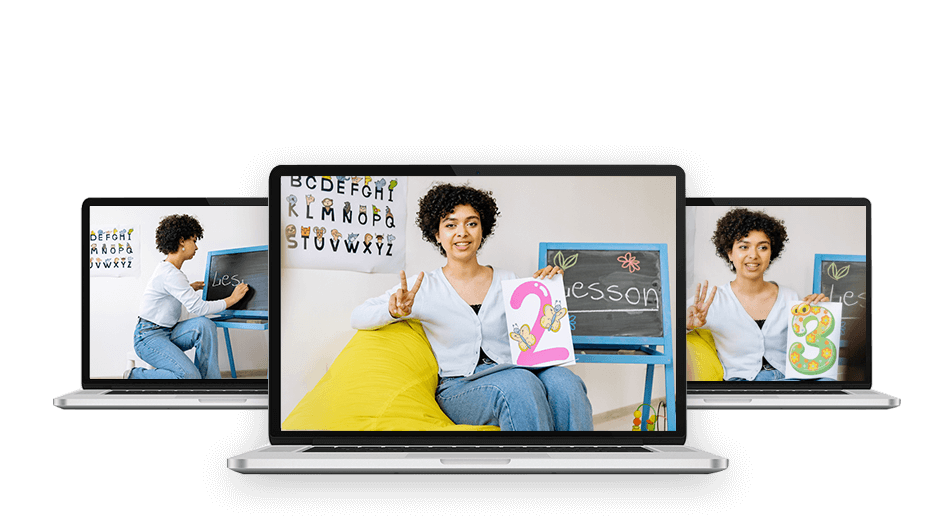One of the biggest trends that continues as the pandemic subsides and schools transition back to in-person instruction, is online learning. Whether it is with those students who choose to continue fully remote learning, or implementing blended learning, or facilitating online homework, or after-hours professional development, or family engagement instruction…online learning is here to stay.
But US school districts continue to search for the most effective strategies and solutions to facilitate online learning that leads to improved academic achievement and teacher quality. Purchases of 1:1 devices and internet access, including installing hot spots, if necessary, to address equity of the homework gap, have consumed district leaders. But training the teachers and finding the best tools to help them implement high quality instruction is key, and finding the funds to acquire such tools is equally as important.
Over the last year, the US Congress has passed three stimulus acts that provide ample funds to support US K-12 schools as they struggled to meet the demands of a massive shift to virtual learning. The first two were to help schools meet these new demands and prepare for a safe return to in-person learning. The third is to prepare for the future. What do teaching and learning look like going forward? These three tranches of funds offer a great deal of flexibility allowing districts to meet their specific needs, which include funding this digital shift.
Concurrently, the US federal government continues to provide ongoing funding through its Elementary and Secondary Education Act, some of which will provide monies for technology purchases.

US FEDERAL EDUCATION STABILIZATION FUNDS
During the course of the pandemic, the US federal government passed three acts to address the health of the population, to stimulate the economy, and to support the business of educating our students despite lack of access to in-person learning and/or reopening our schools. The Education Stabilization Funds were included in each of the three stimulus acts and provide schools the funds to purchase products to address the social and emotional learning of students. Here are the three acts and their contributions to US K-12 education:
- CARES ACT – On March 27, 2020, the Coronavirus Aid, Relief, and Economic Security Act was signed into law. It is a $2 trillion package of assistance measures, including $30.75 billion for an Education Stabilization Fund. Of that $13.75B was allocated for US K-12 education.
- CRRSA ACT – The Coronavirus Response and Relief Supplemental Appropriations Act was signed into law on December 27, 2020 and provides an additional $81.9 billion to the Education Stabilization Fund. Of that amount, $54 billion was allocated for US K-12 programs. The amount of $2.75B for Emergency Assistance to Non-Public Schools (EANS) is also included.
- ARPA – The American Rescue Plan Act was passed by the US Congress March 10, 2021 adding $170 billion to continue support for the Education Stabilization Fund which includes $122 billion allocated to K-12.
Here are more details about what these acts offer to help fund online learning:
THE ELEMENTARY AND SECONDARY EMERGENCY RELIEF FUND (ESSER)
The ESSER Funds I, II and III comprise the majority of funds in the three stimulus acts to help US K-12 schools address the impact of COVID-19 on education, to address the needs of students participating in remote and hybrid learning as well as protections for students to stop the spread of the coronavirus.
- CARES ACT – ESSER I – $13.5B
- CRRSA ACT – ESSER II – $54.3B
- ARP ACT – ESSER III – $122B
Allowable uses of ESSER funds are:
- Providing principals and others school leaders with the resources necessary to address the needs of their individual schools
- Planning for and coordinating on long-term closures (including on meeting IDEA requirements, how to provide online learning)
- Purchasing educational technology (hardware, software, and connectivity) for students, that aids in the regular and substantive educational interaction between students and their classroom instructors, including low-income students and students with disabilities, which may include assistive or adaptive technology
- Summer learning and supplemental after-school programs, including providing classroom instruction or online learning during the summer months and addressing the needs of low-income students, students with disabilities, English learners, migrant students, students experiencing homelessness, and children in foster care
ESSER Fund awards to State Education Agencies (SEAs) are in the same proportion as each State receives funds under Part A of Title I. States then allocate funds to Local Education Agencies (LEAs) based on their specific Title I numbers of students.

They, in turn, may use ESSER funds to purchase the VEDAMO Virtual Classroom to provide educators and tutors with the instructional scaffolding necessary to teach any subject online with the same high quality as in-person.
THE GOVERNOR’S EMERGENCY EDUCATION RELIEF FUND (GEER)
GEER funds were allocated to the United States governors in the first two stimulus acts to address the impact of the pandemic on education. Not only were they encouraged to address safety and health of their students and teachers but also the quality and equity of access vital to virtual learning. GEER funds were allocated:
- 60% on the basis of the state’s relative population of individuals aged 5 through 24.
- 40% on the basis of the number of students who qualify for Title I funds.
This extraordinarily flexible emergency block grant empowered governors to decide how best to meet the current needs of students and schools (including charter schools and non-public schools) within their states. The difference between the two allocations is:
- GEER I – CARES Act – $3B
- A Governor has wide discretion in determining the entities in the State that will receive GEER funds. A Governor can choose to fund only LEAs (Local Education Agencies), only Institutes of Higher Education (IHEs), only education-related entities, or any combination of eligible entities.
- GEER II – CRRSA Act – $4.053B
- $1.3B is intended to help mitigate the impact of COVID-19 on all students and families in public schools.
- Congress set aside $2.75 billion of the GEER II Fund under the CRRSA Act specifically to provide emergency assistance to students and teachers in non-public (i.e., private and parochial) US schools. These funds were also allocated to ensure equitable access through Emergency Access to Non-Public Schools (EANS).
Unless the use of funds is restricted by the US state’s governor, LEAs (including public charter school LEAs) have considerable flexibility in determining how best to use GEER funds. An LEA may use these funds for, among other things, any activities that are authorized under the Elementary and Secondary Education Act (ESEA).
States and LEAs (Local Education Agencies) are encouraged to invest GEER funds in technology infrastructure and professional development that will improve capacity to provide high-quality, accessible, distance education, or remote learning, including:
- Purchasing hardware and software applications for students and teachers
- Providing access to high-quality digital learning content, apps, and tools that can deliver engaging and relevant learning experiences that are accessible to all students
- Covering costs associated with making materials accessible for students with disabilities or English learners
- Providing professional development and training for teachers on effective strategies for the delivery of remote and digital instruction
With GEER II, a non-public school may apply to receive a variety of services or assistance from the SEA to address educational disruptions resulting from COVID-19 (EANS program). EANS funds are dedicated to providing services or assistance to non-public schools that “enroll a significant percentage of low-income students and are most impacted” by the Coronavirus Disease 2019 (COVID-19) pandemic. As with GEER I, SEAs, LEAs and private schools have a great deal of flexibility in how they use the funds to meet the needs of their students.
VEDAMO may be purchased with EANS funds, the guidance for which includes “educational technology (including hardware, software, connectivity, assistive technology, and adaptive equipment) to assist students, educators, and other staff with remote or hybrid learning,” among the eligible services.

ANNUAL FEDERAL EDUCATION FUNDS
US States and school districts have another source of funds to tap for technology purchases that are not COVID related – federal funds that are distributed annually to education. The Elementary and Secondary Education Act (ESEA) is the US nation’s national education law and shows a longstanding commitment to equal opportunity for all students. Enacted in 1965, it has been reauthorized by the US Congress multiple times to address the changing needs of the nation’s students.
BACKGROUND
The most recent reauthorization of ESEA is the Every Student Succeeds Act (ESSA), which was first implemented in 2017. It dictates the education programs that the US federal government funds and distributes to the states on an annual basis. The states then allocate the funds to the LEAs (Local Education Agencies).
Currently, ESSA offers 12 state FORMULA-allocated GRANT programs and 21 COMPETITIVE GRANT programs. Formula programs are based on certain criteria for recipient students. Formula funds are allocated based on the number of students meeting those requirements, such as the number of Title I students. Competitive programs have funds designated for a specific purpose—for example, for 21st Century Community Learning Centers (21 CCLC) — that states, districts, or schools must compete for.
Top ESSA programs that can be used to purchase the VEDAMO Virtual Classroom
TITLE I, PART A: EDUCATION FOR THE DISADVANTAGED
Title I provides financial assistance through State Education Agencies (SEAs) to districts and public schools with high numbers or percentages of poor children to help ensure that all children meet challenging state academic content and student academic achievement standards.
Title I funds are intended to help close the achievement gap between high and low-performing students and increase achievement in academic subjects. These funds may be used by grantees to purchase solutions for students to access digital learning materials and collaborate with peers and educators.
Also, districts may use Title I, Part A funds to acquire curriculum and professional development as part of a comprehensive plan in a Title I schoolwide program school if this use is supported by the school’s comprehensive needs assessment and implemented through evidence-based instructional strategies. To support distance learning, Title I funds must meet the reasonable, allowable and educationally related standard of practice designed to improve the school’s educational program.
VEDAMO is an authorized expenditure as an online learning platform through which distance learning instruction is delivered.
TITLE II, PART A: IMPROVING TEACHER AND PRINCIPAL QUALITY
Title II, Part A is intended to increase student academic achievement consistent with challenging state academic standards, improve the quality and effectiveness of educators, increase the number of educators who are effective in improving student academic achievement in schools, and provide low-income and minority students greater access to effective educators. These funds primarily support the retention and professional development of teachers.
Allowable expenditures include stipends, the cost of professional development activities, contracted services, and reasonable and necessary materials and supplies for use in professional development sessions.
To support distance learning, Title II funds can be used for professional development of staff. VEDAMO is an allowable expenditure as a delivery mechanism for online professional development for staff, which may include support for staff in learning how to use online platforms.

TITLE III: ENGLISH LANGUAGE ACQUISITION
Title III is a supplemental grant under the ESEA that is designed to improve and enhance the education of English learners (ELs) in becoming proficient in English, as well as meeting academic content standards.
Districts may use Title III, Part A funds to improve instruction for ELs, including those with a disability, by acquiring and upgrading curricula and programs, using digital learning resources and software.
VEDAMO can support allowable expenditures under this program such as:
- Providing a medium for tutoring and intensified instruction for EL students, especially given the fact that the VEDAMO Virtual Classroom is available in Spanish as well as English
- Facilitating parent and family engagement, a Title III program requirement
TITLE IV, PART A: STUDENT SUPPORT AND ACADEMIC ENRICHMENT GRANTS
The purpose of Student Support and Academic Enrichment Grants is to improve students’ academic achievement by increasing the capacity of states, LEAs, schools, and local communities to:
- Provide all students with access to a well-rounded education;
- Improve school conditions for student learning; and
- Improve the use of technology in order to improve the academic achievement and digital literacy of all students. Per the funding guidance, states and districts may use Title IV, part A funds for to help educators better discover, use, and share digital content.
- This includes increased access to personalized learning experiences, building technological capacity and infrastructure, carrying out blended learning projects, and professional development in using data and technology to improve instruction.
- There is a limitation that no more than 15 % of funds may be used for purchasing technology infrastructure, including devices, equipment, and software applications.
- At least 85% of the funds for activities to support effective use of technology must be used to support professional learning.
- Funds must only be used to provide additional services, staff, programs, or materials that are not provided with State or local resources absent federal funds.
Title IV-A funds can be used for purchase of equipment, materials, and training needed to support students with online or distance learning platforms.

VEDAMO supports the following qualifying activities under Title IV, part A:
- Increasing access to technology and learning experiences supported by technology
- Providing students in rural, remote, and underserved areas with the resources to take advantage of high-quality digital learning experiences, digital resources, and access to online courses taught by effective educators
- Developing or using effective or innovative strategies for the delivery of specialized or rigorous academic courses and curricula, using technology, including digital learning technologies and assistive technology
- Helping educators and tutors better discover, use, and share digital content
INDIVIDUALS WITH DISABILITIES EDUCATION ACT (IDEA) 611
Individuals with Disabilities Act (IDEA) funds are used to provide education in the “least restrictive environment” for children with disabilities. IDEA 611 funds support US school-aged children ages 5 to 21. Technology solutions may be purchased with these funds if they support the goals of the special education program and the Individual Education Plans (IEPs) of the identified students.
School districts may also use 15% of IDEA funding for early intervention services in regular education—response to intervention (RTI). Funds under this program are combined with state and local funds to provide a free and appropriate education (FAPE) to children with disabilities.
These funds can be used for “coordinated early intervening services” (CEIS), which are services targeted at high-risk, non-disabled children who need additional academic or behavioral support to help them succeed. Basically, they are targeted at students who are on the border of becoming identified as special ed to raise their achievement, so they are NOT identified as special ed student.
VEDAMO enables educators and tutors to offer adaptive learning opportunities that can be tailored for students with special needs, including students with auditory and visual learning needs.
CAREER AND TECHNICAL EDUCATION (CTE) (CARL D. PERKINS ACT)
State grants help US State and local schools offer programs to develop the academic, vocational and technical skills of students in middle and high schools, community colleges, and regional technical centers. The primary intent of the program is to improve or expand career education and improve student academic and technical performance.
One of the purposes of the Perkins Act is to develop more fully the academic knowledge and technical employability skills of special populations to prepare students for high skill, high wage, high demand occupations that will lead to self-sufficiency.
Perkins V funds can be used to purchase technologies as long as they support the CTE instruction. VEDAMO Virtual Classroom can be used across all of CTE’s programs if online.
TITLE V, PART B – RURAL EDUCATION ACHIEVEMENT PROGRAM (REAP)
Rural and Low Income (RLIS) – Funds are to provide rural districts with financial assistance for initiatives aimed at improving student achievement.
LEAs (Local Education Agencies) that receive RLIS grants may use program funds to conduct activities under selected ESEA programs, including the following programs for which VEDAMO products are an eligible expenditure:
- Title I, Part A (Improving Basic Programs Operated by local education agencies)
- Title II, Part A (Supporting Effective Instruction)
- Title III (Language Instruction for English Learners and Immigrant Students)
- Title IV, Part A (Student Support and Academic Enrichment)
TITLE V, PART B – RURAL EDUCATION ACHIEVEMENT PROGRAM (REAP)
Small Rural Schools (SRSA) – The program provides rural LEAs with small enrollments with additional formula funds to improve student achievement.
Recipients may use program funds to conduct activities under selected ESEA programs, including the following programs for which VEDAMO products are an eligible expenditure:
- Title I, Part A (Improving Basic Programs Operated by Local Education Agencies)
- Title II, Part A (Supporting Effective Instruction)
- Title III (Language Instruction for English Learners and Immigrant Students)
- Title IV, Part A (Student Support and Academic Enrichment)
FUNDING CHECKLIST FOR DECISION-MAKERS
In order to secure federal funding for VEDAMO Virtual Classroom, check the following:
- You must first make sure your district/school is eligible for those funds. Click on the URL of the funding sources below for more information.
- How many students qualify as Title I? Some of the other formula program allocations are based on that same number. For example:
- The Stimulus funds: CARES Act, CRRSA Act, ARP Act
- Title IV, Part A
To find out how much your district is getting for Title I, check the following URL. Find your state and open the EXCEL spreadsheet to find your district: Title I Tables
- Will the VEDAMO Virtual Classroom be used to serve the students that receive the specific funding? For example, Title III funds are allocated in proportion to the number of EL students in the school(s) and must only be used to serve those students.
- Identify the number of students in special populations, such as:
- IDEA funds – students who receive special education services
- Title III – English Language Learners
The funds that they are eligible for can be used for purchasing technology to support the needs of qualifying students.
- If there are rural schools in the district, check eligibility for Title V, Part B – Rural Education Achievement Program or Small Rural Schools Funds.
- Ensure the district’s or school’s technology program focus meets the funding requirements of the federal program you intend to use. Understand how the funds can be used for technology and why VEDAMO qualifies.
- Is the district continuing, expanding or adding virtual learning options? The American Rescue Plan funds and Non-Public School funds (EANS) may be used to purchase technology to support such programs.
